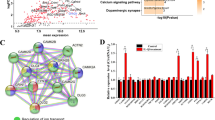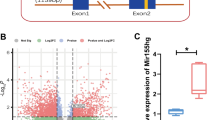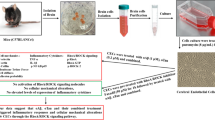Abstract
Regulators of mitogen activated protein kinases (MAPK) and c-Jun N-terminal/stress-activated kinase (JNK) include Rho-like small GTP-binding proteins and their regulators. SynGAP and kalirin-7 are postsynaptic density-enriched proteins identified through their interaction with Rho GTPases and PSD-95 scaffold protein. We examined immunoreactivity of SynGAP, kalirin-7, and PSD-95, phosphorylation of MAPK and JNK in control and postischemic hippocampus in gerbil model of transient forebrain ischemia. In normal brain higher amount of kalirin-7 but a lower amount of P-JNK was found in ischemia-resistant hippocampal area: CA2-3, DG than in ischemia-vulnerable CA1. After 5 min ischemia and 1 h reperfusion a decrease of P-ERK and increase of P-JNK were uniformly observed in the hippocampal parts. By contrast, the amount of kalirin-7 in CA2-3, DG reached 56% (P < 0.001) of control while was doubled in CA1. Oppositely, the immunoreactivity of SynGAP was increased in CA2-3, DG and reduced in CA1. Our data indicate that SynGAP and kalirin-7 take part in the regulation of ischemic signal transduction but the mechanism does not seem directly connected with the activation of MAPK and JNK.


Similar content being viewed by others
References
Takagi N, Logan R, Teves L et al (2000) Altered interaction between PSD-95 and the NMDA receptor following transient global ischemia. J.Neurochem 74:169–178
Sheng M, Kim MJ (2002) Postsynaptic signaling and plasticity mechanisms. Science 298:776–780
Kukekov NV, Xu Z, Greene LA (2006) Direct interaction of the molecular scaffolds POSH and JIP is required for apoptotic activation of JNKs. J Biol Chem 281:15517–15524
Yamauchi J, Miyamoto Y, Sanbe A et al (2006) JNK phosphorylation of paxillin, acting through the Rac1 and Cdc42 signaling cascade, mediates neurite extension in N1E-115 cells. Exp.Cell Res 312:2954–2961
Derkinderen P, Enslen H, Girault JA (1999) The ERK/MAP-kinases cascade in the nervous system. Neuroreport 10:R24–R34
Rumbaugh G, Adams JP, Kim JH et al (2006) SynGAP regulates synaptic strength and mitogen-activated protein kinases in cultured neurons. Proc Natl Acad Sci USA 103:4344–4351
Komiyama NH, Watabe AM, Carlisle HJ et al (2002) SynGAP regulates ERK/MAPK signaling, synaptic plasticity, and learning in the complex with postsynaptic density 95 and NMDA receptor. J Neurosci 22:9721–9732
Rabiner CA, Mains RE, Eipper BA (2005) Kalirin: a dual Rho guanine nucleotide exchange factor that is so much more than the sum of its many parts. Neuroscientist 11:148–160
Pei L, Teves RL, Wallace MC et al (2001) Transient cerebral ischemia increases tyrosine phosphorylation of the synaptic RAS-GTPase activating protein, SynGAP. J Cereb Blood Flow Metab 21:955–963
Ma XM, Huang J, Wang Y et al (2003) Kalirin, a multifunctional Rho guanine nucleotide exchange factor, is necessary for maintenance of hippocampal pyramidal neuron dendrites and dendritic spines. J Neurosci 23:10593–10603
Penzes P, Johnson RC, Sattler R et al (2001) The neuronal Rho-GEF Kalirin-7 interacts with PDZ domain-containing proteins and regulates dendritic morphogenesis. Neuron 29:229–242
Penzes P, Johnson RC, Alam MR et al (2000) An isoform of kalirin, a brain-specific GDP/GTP exchange factor, is enriched in the postsynaptic density fraction. J Biol Chem 275:6395–6403
Xu Z, Kukekov NV, Greene LA (2003) POSH acts as a scaffold for a multiprotein complex that mediates JNK activation in apoptosis. EMBO J 22:252–261
Zablocka B, Dluzniewska J, Zajac H et al (2003) Opposite reaction of ERK and JNK in ischemia vulnerable and resistant regions of hippocampus: involvement of mitochondria. Brain Res Mol Brain Res 110:245–252
Gu Z, Jiang Q, Zhang G (2001) c-Jun N-terminal kinase activation in hippocampal CA1 region was involved in ischemic injury. Neuroreport 12:897–900
Pei DS, Sun YF, Guan QH, Hao ZB, Xu TL, Zhang GY (2004) Postsynaptic density protein 95 antisense oligodeoxynucleotides inhibits the activation of MLK3 and JNK3 via the GluR6.PSD-95.MLK3 signaling module after transient cerebral ischemia in rat hippocampus. Neurosci Lett 367:71–75
Zablocka B, Lukasiuk K, Lazarewicz JW et al (1995) Modulation of ischemic signal by antagonists of N-methyl-D-aspartate, nitric oxide synthase, and platelet-activating factor in gerbil hippocampus. J Neurosci Res 40:233–240
Centeno C, Repici M, Chatton JY et al (2007) Role of the JNK pathway in NMDA-mediated excitotoxicity of cortical neurons. Cell Death Differ 14:240–253
Cui H, Hayashi A, Sun HS et al (2007) PDZ protein interactions underlying NMDA receptor-mediated excitotoxicity and neuroprotection by PSD-95 inhibitors. J Neurosci 27:9901–9915
Aarts M, Liu Y, Liu L et al (2002) Treatment of ischemic brain damage by perturbing NMDA receptor-PSD-95 protein interactions. Science 298:846–850
Semenova MM, Maki-Hokkonen AM, Cao J et al (2007) Rho mediates calcium-dependent activation of p38alpha and subsequent excitotoxic cell death. Nat Neurosci 10:436–443
Kim JH, Lee HK, Takamiya K et al (2003) The role of synaptic GTPase-activating protein in neuronal development and synaptic plasticity. J Neurosci 23:1119–1124
Ouyang YB, Tan Y, Comb M et al (1999) Survival- and death-promoting events after transient cerebral ischemia: phosphorylation of Akt, release of cytochrome C and activation of caspase-like proteases. J Cereb Blood Flow Metab 19:1126–1135
Zhang QG, Wang XT, Han D et al (2006) Akt inhibits MLK3/JNK3 signaling by inactivating Rac1: a protective mechanism against ischemic brain injury. J Neurochem98:1886–1898
Shen YH, Godlewski J, Zhu J et al (2003) Cross-talk between JNK/SAPK and ERK/MAPK pathways: sustained activation of JNK blocks ERK activation by mitogenic factors. J Biol Chem 278:26715–26721
Shackelford DA, Yeh RY (2003) Activation of extracellular signal-regulated kinases (ERK) during reperfusion of ischemic spinal cord. Brain Res Mol Brain Res 115:173–186
Chakrabarti K, Lin R, Schiller NI et al (2005) Critical role for Kalirin in nerve growth factor signaling through TrkA. Mol Cell Biol 25:5106–5118
Ratovitski EA, Alam MR, Quick RA et al (1999) Kalirin inhibition of inducible nitric-oxide synthase. J Biol Chem 274:993–999
Xie Z, Srivastava DP, Photowala H et al (2007) Kalirin-7 controls activity-dependent structural and functional plasticity of dendritic spines. Neuron 56:640–656
Ma XM, Wang Y, Ferraro F et al (2008) Kalirin-7 is an essential component of both shaft and spine excitatory synapses in hippocampal interneurons. J Neurosci 28:711–724
Goehler H, Lalowski M, Stelzl U et al (2004) A protein interaction network links GIT1, an enhancer of huntingtin aggregation, to Huntington’s disease. Mol Cell 15:853–865
Wang L, Hauser ER, Shah SH et al (2007) Peakwide mapping on chromosome 3q13 identifies the kalirin gene as a novel candidate gene for coronary artery disease. Am J Hum Genet 80:650–663
Youn H, Jeoung M, Koo Y et al (2007) Kalirin is under-expressed in Alzheimer’s disease hippocampus. J Alzheimers Dis 11:385–397
Youn H, Ji I, Ji HP et al (2007) Under-expression of Kalirin-7 Increases iNOS activity in cultured cells and correlates to elevated iNOS activity in Alzheimer’s disease hippocampus. J Alzheimers Dis 12:271–281
Sulkowski G, Struzynska L, Lenkiewicz A et al (2006) Changes of cytoskeletal proteins in ischaemic brain under cardiac arrest and reperfusion conditions. Folia Neuropathol 44:133–139
Jourdain P, Nikonenko I, Alberi S et al (2002) Remodeling of hippocampal synaptic networks by a brief anoxia-hypoglycemia. J Neurosci 22:3108–3116
Gisselsson LL, Matus A, Wieloch T (2005) Actin redistribution underlies the sparing effect of mild hypothermia on dendritic spine morphology after in vitro ischemia. J Cereb Blood Flow Metab 25:1346–1355
Acknowledgments
The project was sponsored by the Polish Ministry of Science and Higher Education 2P04A 024 28 and statutory grant to Mossakowski Medical Research Centre.
Author information
Authors and Affiliations
Corresponding author
Rights and permissions
About this article
Cite this article
Beręsewicz, M., Kowalczyk, J.E. & Zabłocka, B. Kalirin-7, a Protein Enriched in Postsynaptic Density, is Involved in Ischemic Signal Transduction. Neurochem Res 33, 1789–1794 (2008). https://doi.org/10.1007/s11064-008-9631-y
Received:
Accepted:
Published:
Issue Date:
DOI: https://doi.org/10.1007/s11064-008-9631-y




